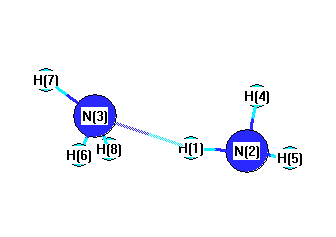Vibrational Frequencies calculated at B1B95/CEP-31G*
| Mode Number |
Symmetry |
Frequency
(cm-1) |
Scaled Frequency
(cm-1) |
IR Intensities
(km mol-1) |
Raman Act
(Å4/u) |
Dep P |
Dep U |
|---|
| 1 |
A |
3650 |
3494 |
0.00 |
|
|
|
| 2 |
A |
3503 |
3353 |
0.00 |
|
|
|
| 3 |
A |
1712 |
1639 |
0.00 |
|
|
|
| 4 |
A |
1161 |
1111 |
0.00 |
|
|
|
| 5 |
A |
548 |
524 |
0.00 |
|
|
|
| 6 |
A |
163 |
156 |
0.00 |
|
|
|
| 7 |
A |
3661 |
3505 |
1.69 |
|
|
|
| 8 |
A |
1718 |
1645 |
35.08 |
|
|
|
| 9 |
A |
242 |
232 |
144.74 |
|
|
|
| 10 |
A |
84 |
80 |
31.77 |
|
|
|
| 11 |
A |
3661 |
3504 |
0.00 |
|
|
|
| 12 |
A |
1704 |
1631 |
0.00 |
|
|
|
| 13 |
A |
107 |
102 |
0.00 |
|
|
|
| 14 |
A |
3644 |
3488 |
26.65 |
|
|
|
| 15 |
A |
3502 |
3353 |
16.09 |
|
|
|
| 16 |
A |
1683 |
1611 |
21.39 |
|
|
|
| 17 |
A |
1107 |
1060 |
437.75 |
|
|
|
| 18 |
A |
208 |
199 |
308.24 |
|
|
|
Unscaled Zero Point Vibrational Energy (zpe) 16029.4 cm
-1
Scaled (by 0.9572) Zero Point Vibrational Energy (zpe) 15343.4 cm
-1
See section
III.C.1 List or set vibrational scaling factors
to change the scale factors used here.
See section
III.C.2
Calculate a vibrational scaling factor for a given set of molecules
to determine the least squares best scaling factor.
Charges, Dipole, Quadrupole and Polarizability
Charges from optimized geometry at B1B95/CEP-31G*
Charges (e)
| Number |
Element |
Mulliken |
CHELPG |
AIM |
ESP |
| 1 |
H |
0.295 |
|
|
|
| 2 |
N |
-0.820 |
|
|
|
| 3 |
N |
-0.820 |
|
|
|
| 4 |
H |
0.262 |
|
|
|
| 5 |
H |
0.262 |
|
|
|
| 6 |
H |
0.295 |
|
|
|
| 7 |
H |
0.262 |
|
|
|
| 8 |
H |
0.262 |
|
|
|
Electric dipole moments
Electric dipole components in Debye
(What's a Debye? See section
VII.A.3)
| |
x |
y |
z |
Total |
| |
0.000 |
0.000 |
0.000 |
0.000 |
| CHELPG |
|
|
|
|
| AIM |
|
|
|
|
| ESP |
|
|
|
|
Electric Quadrupole moment
Quadrupole components in D Å
| Primitive |
|---|
| | x | y | z |
|---|
| x |
-16.586 |
4.629 |
0.000 |
| y |
4.629 |
-8.649 |
0.000 |
| z |
0.000 |
0.000 |
-12.087 |
|
| Traceless |
|---|
| | x | y | z |
|---|
| x |
-6.218 |
4.629 |
0.000 |
| y |
4.629 |
5.687 |
0.000 |
| z |
0.000 |
0.000 |
0.531 |
|
| Polar |
|---|
| 3z2-r2 | 1.062 |
|---|
| x2-y2 | -7.937 |
|---|
| xy | 4.629 |
|---|
| xz | 0.000 |
|---|
| yz | 0.000 |
|---|
|
Polarizabilities
Components of the polarizability tensor.
Units are
Å
3 (Angstrom cubed)
Change units.
| |
x |
y |
z |
| x |
1.701 |
-0.222 |
0.000 |
| y |
-0.222 |
3.444 |
0.000 |
| z |
0.000 |
0.000 |
2.899 |
<r2> (average value of r
2) Å
2
| <r2> |
0.000 |
| (<r2>)1/2 |
0.000 |
